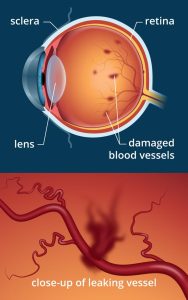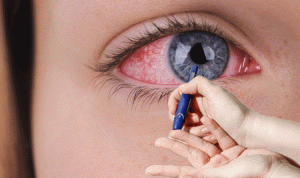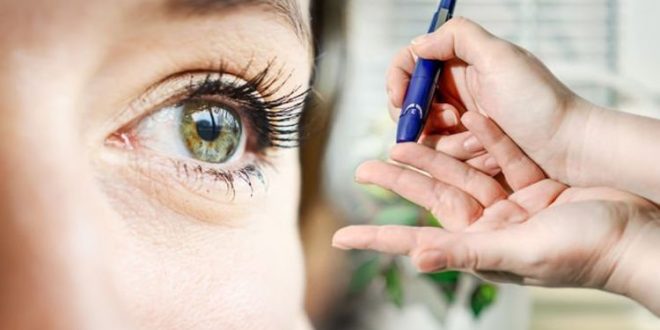The chronic disease of diabetes, which is characterized by elevated levels of blood sugar, is a rising worldwide health issue. One of the less well-known but essential complications of diabetes is its impact on the health of the eyes. A high blood sugar level can result in a myriad of eye conditions commonly referred to as diabetic eye disorders. Knowing the link between high blood sugar levels and eye health is essential for preventing loss of vision and maintaining overall health. This article focuses on the connection between high blood sugar and eye health. It also outlines the particular circumstances that it may cause and strategies for prevention and treatment.
Understanding Diabetes and Blood Sugar Levels
What is Diabetes?
Diabetes is a metabolic disorder that hinders your body’s capacity to control the levels of blood sugar. There are two forms of diabetes:
- Type 1 diabetes: A condition that is autoimmune in which the body attacks infected cells that produce insulin inside the pancreas. This means the body cannot make insulin, requiring permanent insulin treatment.
- Type 2 Diabetes is when the body cannot respond to insulin or fails to make satisfying insulin. This type of diabetes is more frequent and is usually related to the lifestyle of a person, for example, weight gain and lack of physical activity.
Blood Sugar Levels and Their Importance
Blood sugar levels indicate the amount of glucose present in the blood. Normal blood sugar levels vary from 70-99 mg/dL. Diabetic patients are diagnosed when their blood sugar levels in the fasting period consistently exceed 126 mg/dL. Keeping blood sugar levels within the target level is crucial to avoid complications related to diabetes, like ones that affect the eyes.
How High Blood Sugar Affects the Eyes
High blood sugar and eye health are closely related to each other. As high blood sugar levels could damage different structures of the eye, notably the blood vessels that line the retina. The retina is a light-sensitive layer in the back of the eye which plays an essential part in vision. The damage to retinal blood vessels can cause many eye disorders, commonly referred to as diabetic eye diseases.
Diabetic Retinopathy
Diabetic retinal disease is the most prevalent eye disease in diabetics and a significant cause of blindness for adults. It develops when elevated glucose levels damage the retina’s tiny blood vessels, causing swelling, leakage, and the development of unusual blood vessels.
Stages of Diabetic Retinopathy
- Non-Proliferative Diabetic Retinopathy (NPDR):
-
- This stage is initially marked by blood vessels within the retina that leak fluid and blood.
-
- Microaneurysms (small bulges that occur in blood vessels) develop as well, as a rise in the size of your retina (oedema) can develop.
- Proliferative Diabetic Retinopathy (PDR):
-
- In this stage, new abnormal blood vessels are formed in the retina and the vitreous (the gel-like substance inside the eye).
-
- These vessels can rupture, causing vitreous haemorrhage and leading to scar tissue growth, which may result in retinal detachment.
Diabetic Macular Edema (DME)
Diabetic macular oedema occurs when fluid builds up inside the macula, the retina’s central portion responsible for clear, precise vision. The condition can lead to vision blurriness and distortion, significantly affecting our quality of life.
Cataracts
Diabetics are more at risk of developing cataracts, a condition in which the eye’s lens becomes cloudy and leads to blurred vision. High blood sugar levels could alter the lens’s proteins and water content, accelerating cataract formation.
Glaucoma
Diabetes can lead to Glaucoma, an assortment of eye diseases that can damage the optic nerve. This is usually because of increased intraocular pressure. Diabetic retinal disease can also lead to neovascular Glaucoma. New blood vessels, which are not normal, block the eye’s drainage system and increase pressure.
Mechanisms Linking High Blood Sugar to Eye Damage
Many physiological reasons explain why high blood sugar levels can lead to eye damage.
Oxidative Stress
High blood sugar levels boost free radical levels, increasing oxidative stress. This damage to tissues and cells, such as retinas, contributes to developing diabetic eye disease and other eye diseases.
Inflammation
Chronically high blood sugar levels, including in the eye, trigger lower-grade inflammation. Inflammatory molecules may damage retinal cells and blood vessels and can cause the onset of eye disease caused by diabetes.
Advanced Glycation End Products (AGEs)
AGEs are harmful substances that form when fats or proteins combine with blood sugars. The high blood sugar levels can accelerate the development of AGEs. These can cause damage to blood vessels and contribute to the development of diabetic retinopathy.
Vascular Changes
High blood sugar levels can cause endothelial damage, which affects blood vessels’ capacity to constrict and dilate effectively. This causes increased leakage and permeability, which contributes to the swelling of the retina and the development of abnormal blood vessels.

Symptoms of Diabetic Eye Diseases
The early diagnosis of eye diseases caused by diabetes is vital for effective treatment. But, many of these diseases do not show symptoms in the early stages. As the illness progresses, symptoms can include:
- Vision blurred or discoloured.
- The Floaters (spots of dark string floating within the vision field)
- Night vision is challenging to see
- The vision is dark, or there are empty areas in the vision.
- Sudden vision loss
Regular exams of the eyes are crucial for the early detection and treatment of eye disease caused by diabetes.
Prevention and Management of Diabetic Eye Diseases
Blood Sugar Control
Achieving blood sugar levels that are within the desired range is the most effective method to stop or slow the development of eye disease caused by diabetes. This can be accomplished by a combination of
- The Healthy Diet: A proper diet with plenty of fruits, vegetables, whole grains, and protein-rich lean proteins can help regulate the levels of blood sugar.
- Regular exercise: Physical activity improves insulin sensitivity and aids in maintaining the blood sugar level.
- Medicines: Insulin or oral hypoglycemic medications can be prescribed by a doctor to regulate glucose levels in the blood.
- Monitoring your blood sugar regularly can help identify trends and modify treatment plans in line with them.
Blood Pressure and Cholesterol Management
High blood pressure and cholesterol levels can exacerbate the effects of diabetic eye disease. Treatment of these conditions through changes in lifestyle and medications will reduce the chance of eye-related complications.
Regular Eye Exams
Comprehensive eye exams every year are essential for the early detection of eye diseases caused by diabetes. These eye exams should comprise the following:
- Dilated Eye Examination: This allows the eye doctor to look at the optic nerve and retina for evidence of damage.
- Vision Acuity Test Tests your ability to see over a variety of distances.
- Tonometry measures the intraocular pressure, which can be used to identify the presence of Glaucoma.
- Optic Coherence Tomography (OCT): Provides precise retina photographs that help detect macular oedema.
Treatment Options
A variety of treatment options are offered to treat diabetes-related eye disorders:
Laser Therapy
Photocoagulation, also known as laser therapy, is a method to treat diabetic retinopathy and macular oedema caused by diabetes. It involves using lasers to block blood vessels that leak and to reduce the abnormal growth of blood vessels.
Anti-VEGF Injections
Anti-VEGF (vascular endothelial growth factor) injections benefit by reducing the growth of abnormal blood vessels and fluid leakage from the retina. The injections are typically utilized to treat diabetic macular oedema and proliferative diabetes retinal diseases.
Corticosteroid Injections
Corticosteroid injections may reduce swelling and inflammation within the retina, especially in the case of macular oedema due to diabetes.
Vitrectomy
Vitrectomy is a surgical procedure that involves the removal of the vitreous gel as well as any scar tissue or blood of the retina. It is utilized to treat advanced diabetic retinopathy and bleeding in vitreous.

Lifestyle Tips for Protecting Eye Health
Healthy Diet
A diet high in antioxidants, vitamins and minerals can improve your eyes’ health. Include vegetables, leafy greens, carrots, citrus fruits, sweet potatoes, and fatty fish in your daily diet.
Quit Smoking
Smoking cigarettes increases the chance of developing diabetic retinopathy as well as other eye diseases. Smoking less can significantly lower the risk and improve the overall quality of life.
Protect Your Eyes
Wearing sunglasses with UV protection will protect your eyes from damaging ultraviolet rays and reduce the chance of developing cataracts and other eye problems.
Manage Stress
Stress-related stress can adversely affect the control of blood sugar levels and general health. Stress-management techniques like yoga, meditation or deep breathing can increase your health and help keep your blood sugar levels stable. Levels.
Stay Informed
Be aware of the effects of diabetes on eye health. Being informed allows you to make better decisions about your health and also encourages proactive treatment of the disease.
The Role of Healthcare Providers
Effective treatment of eye disease caused by diabetes is a multidisciplinary process that involves different healthcare professionals:
Primary Care Physicians
Primary healthcare providers are essential in managing diabetes and providing treatment. They monitor blood sugar levels, recommend medicines, and refer patients to specialists if necessary.
Endocrinologists
Endocrinologists are experts in the management of hormonal disorders, including diabetes. They focus on providing professional guidance regarding insulin treatment, medication adjustment, and lifestyle changes to achieve the highest blood sugar levels.
Ophthalmologists
Ophthalmologists are medical professionals who specialize in eye health. They conduct comprehensive eye exams, diagnose eye disorders such as diabetes, and offer treatments such as injections, laser therapy, and surgeries.
Optometrists
Optometrists offer additional regular eye care, including eye tests, as well as an assessment of the fit of glasses for correction. They also play an essential role in identifying the early signs of eye disease caused by diabetes and refer patients to ophthalmologists for further examination and treatment.
Dietitians
Registered dietitians can favour personalized diet guidance to control your blood sugar. They can create meals that promote overall health and avoid complications associated with diabetes.
Diabetes Educators
Accredited diabetes educators favour training and support to help those with diabetes manage their condition. They provide self-care tips such as checking blood sugar, taking medication, and making healthy lifestyle choices.
Future Directions in Prevention and Treatment
1. Improved Glycemic Control
A tight glycemic control is the mainstay of prevention against diabetic eye conditions. The future research focus is on the development of new medicines and techniques for benefit sufferers accomplish and maintain healthy glucose levels.
- next-generation insulins It is the subject of ongoing research to develop insulins that have quicker onset and longer duration of action that can more closely mimic your body’s insulin response.
- Closed-Loop System The latest developments in technology for diabetes, like close-loop systems for insulin distribution (artificial pancreas) can help patients keep their blood sugar levels stable without enough effort.
2. Anti-VEGF Therapies
Anti-VEGF (vascular endothelial cellular growth factor) treatments have revolutionized treatment of macular edema caused by diabetes and proliferative diabetic eye retinopathy. Future research focuses on improving the effectiveness of these treatments as well as investigating new delivery strategies.
- Sustained Release Implants The research team is currently investigating implantables that sustain release and help in providing a constant dose of anti-VEGF medication for several months, thus reducing the need for repeated injections.
- Combination Therapy Combining anti-VEGF medications along with extra treatments like corticosteroids, or anti-inflammatory agents is being researched to improve efficacy and minimize the risk of adverse reactions.
3. Novel Therapeutic Targets
In the process of research, researchers are identifying new therapeutic targets, which go beyond VEGF to treat the eye disease caused by diabetes.
- Rho-Associated Protein Kinase (ROCK) Inhibitors: ROCK inhibitors are being investigated for their ability to decrease retinal fibrosis as well as the neovascularization of diabetic retinopathy.
- Sirtuins as well as NADModulators Sirtuins are a family of proteins that play a role in the cellular response to stress as well as NAD+ (nicotinamide adenine dinucleotide) modulators are being studied to determine their effects on protecting retinal cells.
4. Regenerative Medicine
Regenerative medicine is a promising opportunity for the restoration of vision in patients suffering from advanced eye disease caused by diabetes.
- Stem Cell Therapie: Stem cell therapy seeks at replacing retinal damaged cells with healthier ones. Researchers are investigating the potential of different stem cell types, such as the induced pluripotent stem cell (iPSCs) used for retinal regeneration.
- Retinal Implants Implants for the retina and prosthetic devices are being designed to restore vision for people with severe damage to their retinas. The devices transform light signals into electric ones that trigger the remaining healthy retinal cells.
5. Personalized Medicine
Individualized medicine strategies are increasing important in the management of conditions that cause eye disease in diabetics. Through adjusting treatments compatible to the genetic profile of an individual and lifestyle as well as disease features, doctors can complete more effective outcomes.
- Genetic Tests Genetic testing is a way to determine those at risk of developing diabetic retinopathy. making it possible to intervene earlier and develop individual treatment strategies.
- Lifestyle interventions Lifestyle interventions that are tailored to your needs that include exercises and diet plans, could benefit people manage your blood sugar level more definitely and decrease the chance of developing eye problems.
Conclusion
The relationship between blood sugar levels and eye health has been well-established with eye conditions caused by diabetes posing an increased risk for those suffering from diabetes. But, advances in technology and research have opened the way for better diagnosis, prevention, and treatment of these ailments. By focusing on understanding the fundamental mechanisms, creating new treatments as well as embracing multidisciplinary and personalized care strategies The future is promising to boost eye health and living quality for those suffering from diabetes. Continuous research and development are crucial to reaching these goals and eventually lessening the burden of diabetes-related eye diseases across the globe.
FAQs
How does high blood sugar affect eye health?
High blood sugar damages the blood vessels in the retina, leading to diabetic eye diseases such as diabetic retinopathy, diabetic macular edema, cataracts, and glaucoma.
What are the symptoms of diabetic eye diseases?
Symptoms may include blurred or distorted vision, floaters, difficulty seeing at night, dark or empty areas in vision, and sudden vision loss.
What treatments are available for diabetic retinopathy?
Treatments include laser therapy, anti-VEGF injections, corticosteroid injections, and vitrectomy surgery for advanced cases.
How does high blood sugar cause cataracts?
High blood sugar can cause changes in the lens’s proteins and water content, leading to clouding and cataract formation.
 aim specialty health Discover Expert Insights, Empower Your Wellness With Aim Specialty Health Blogs.
aim specialty health Discover Expert Insights, Empower Your Wellness With Aim Specialty Health Blogs.




